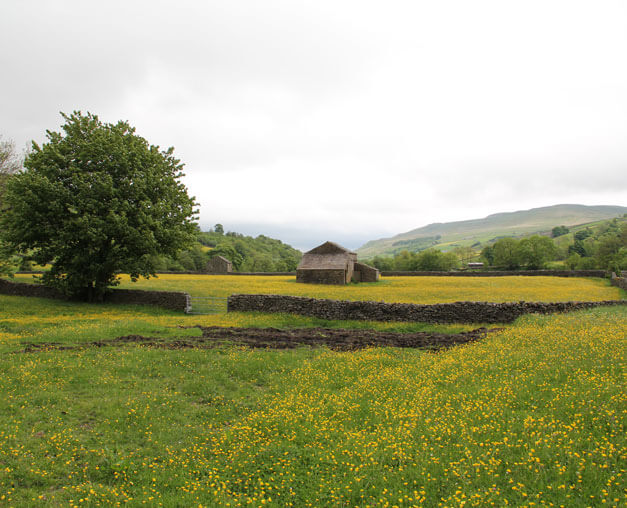
Oxnop Gill and Ivelet Bridge
From Muker 8.5 miles (13.7km)
The attractive village of Muker is situated at the foot of Kisdon Hill. Its clusters of grey stone cottages huddle together above the beck, which merges with the river Swale below the bridge to the east. Muker has several interesting buildings, including the old school endowed in 1678 and rebuilt in 1849, the literary institute of 1868 and the prominent St Mary’s Church.
The church was one of the few to be built in England during the reign of Elizabeth I. It was initially founded as a chapel of ease under Grinton, but in 1580 it was significantly rebuilt and a graveyard was consecrated. This meant that the residents of Upper Swaledale no longer needed to take their dead to the parish church at Grinton for burial. The church was enlarged in 1761 with a higher roof and restored in 1890 when the musicians’ gallery was removed. The bells are thought to have been brought from Ellerton Priory after the Dissolution.
Muker still holds an annual show on the first Wednesday in September, showing some of the finest Swaledale tups and ewes. Other events include sheepdog trials, dry-stone walling demonstrations, local craft and trade stalls, horse and pony events, vintage tractors, fell racing and much more.
Muker’s Silver Band plays at the show throughout the day. The band was formed by subscription in 1897 to mark Queen Victoria’s impending Diamond Jubilee. It is one of the last surviving bands in the northern dales, with a good majority of the players, whose ages range from ten to seventy, still hailing from within a few miles of the village. Since the 1970s the band’s popularity has seen a revival due to a number of television performances. These include shows such as Go With Noakes, All Creatures Great and Small, Highway and several appearances on Dales Diary.

The walk begins with a crossing of the steep hillside to the road above Crow Trees Farm. Although narrow, this road is fairly quiet and leads uphill above Oxnop Gill to Oxnop Scar.
Oxnop Gill is a deeply cut side valley, the lower part being a fine example of a gill wood. These woods are the remains of former birch forests, once covering the upper fells stretching to the open moor. In contrast, the upper gill has some attractive waterfalls and the magnificent outcrop of Oxnop Scar. Along the top of the scar, there are splendid views of Kisdon Hill and the fells beyond.

From Oxnop Scar we descend along a tarmac lane passing Gill Head, a longhouse style farmhouse. These were built with a living area, a cow shed and a barn, all incorporated under one roof. Just below the farmhouse there is a beautiful panorama of the valley stretching from Muker to Gunnerside.
Directly opposite, above the hamlet of Ivelet, is Gunnerside Lodge, which belongs to the American billionaire Robert Miller, whose Hong Kong-based financial empire grew from the sales of duty-free drinks. Miller, who is now a British citizen, remains based in Hong Kong, but has homes in London, New York, Paris and Gstaad. He purchased the Gunnerside estate for £9m in 1995. It is one of the largest country estates in Britain and covers an area of 32,000 acres (12,950Ha).
After reaching Satron we continue along a meadow path leading to the river Swale and the highlight of our walk. The splendid packhorse bridge at Ivelet, which has an attractive single-spanned high stone arch, was built in about 1695. The area around the bridge is so quiet that it is easy to imagine the packhorses laden with their heavy panniers crossing over the bridge and plodding their way along the peaceful, tree-shaded lane. According to local folklore, the locality around this ancient bridge is haunted by a headless dog which brings bad luck to anyone unfortunate enough to see it. The dubious canine is usually sighted gliding across the bridge, where it disappears over the edge.
From the bridge we follow a clear path through lush meadows, never straying far from the riverside and return to Muker. This is an area of outstanding natural beauty and is designated environmentally sensitive.
Across the river is the Yelland’s Meadow Nature Reserve, belonging to the Yorkshire Wildlife Trust. This meadow is farmed by a local farmer using traditional methods and is free from artificial fertilisers. Hay meadows are seen at their best from the beginning of June to mid-July, when wildflowers flood the valley with colour.
